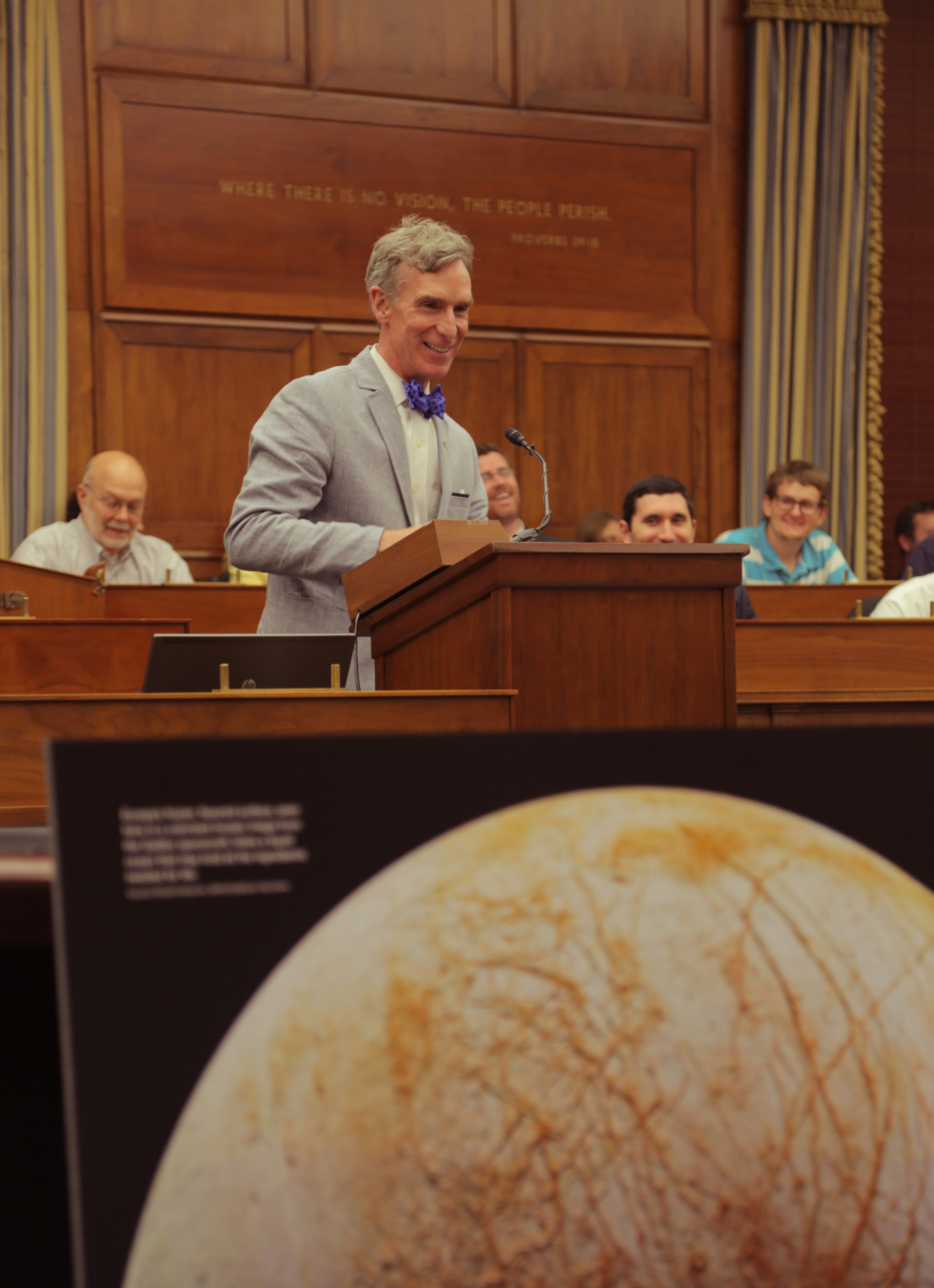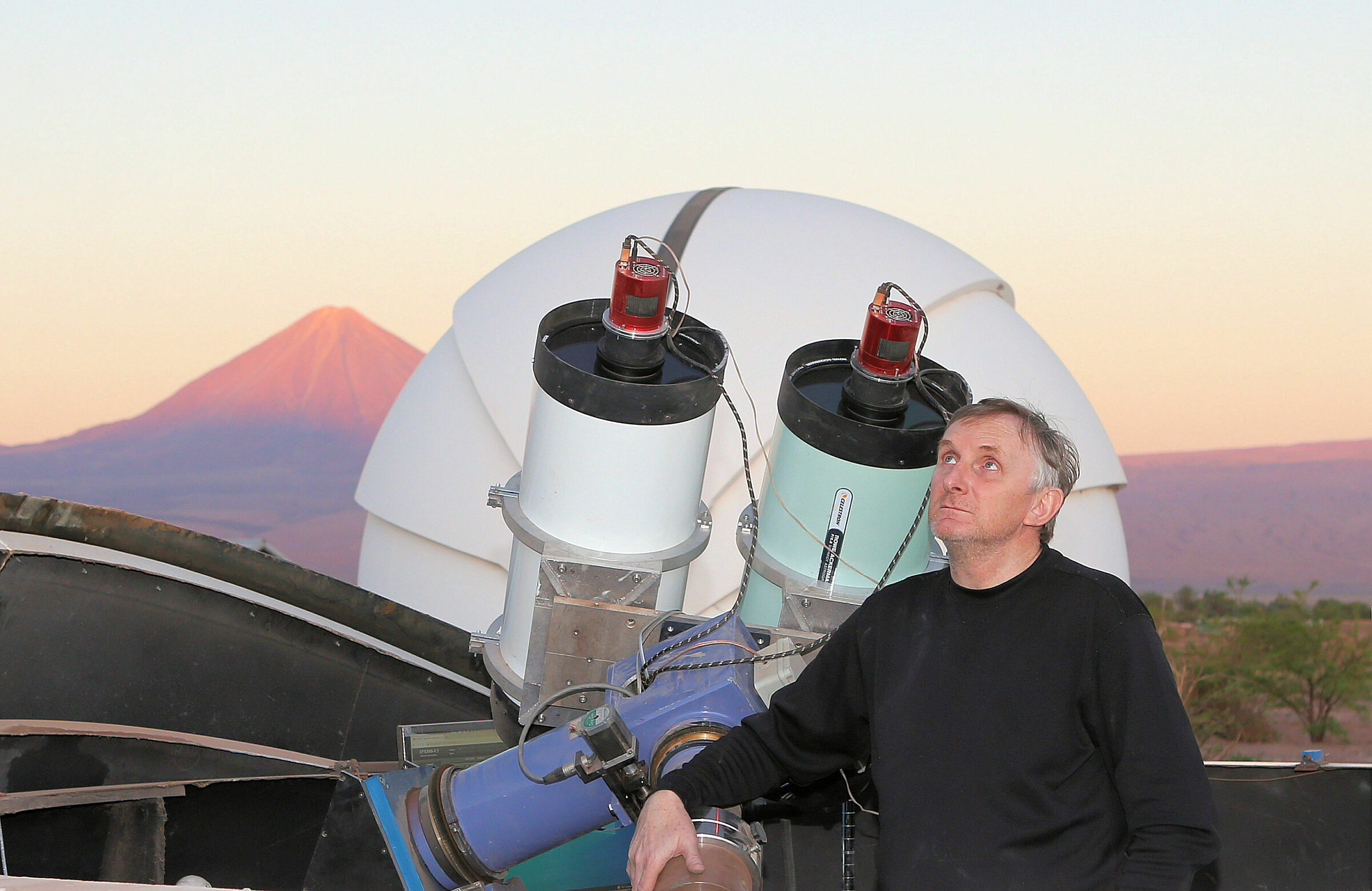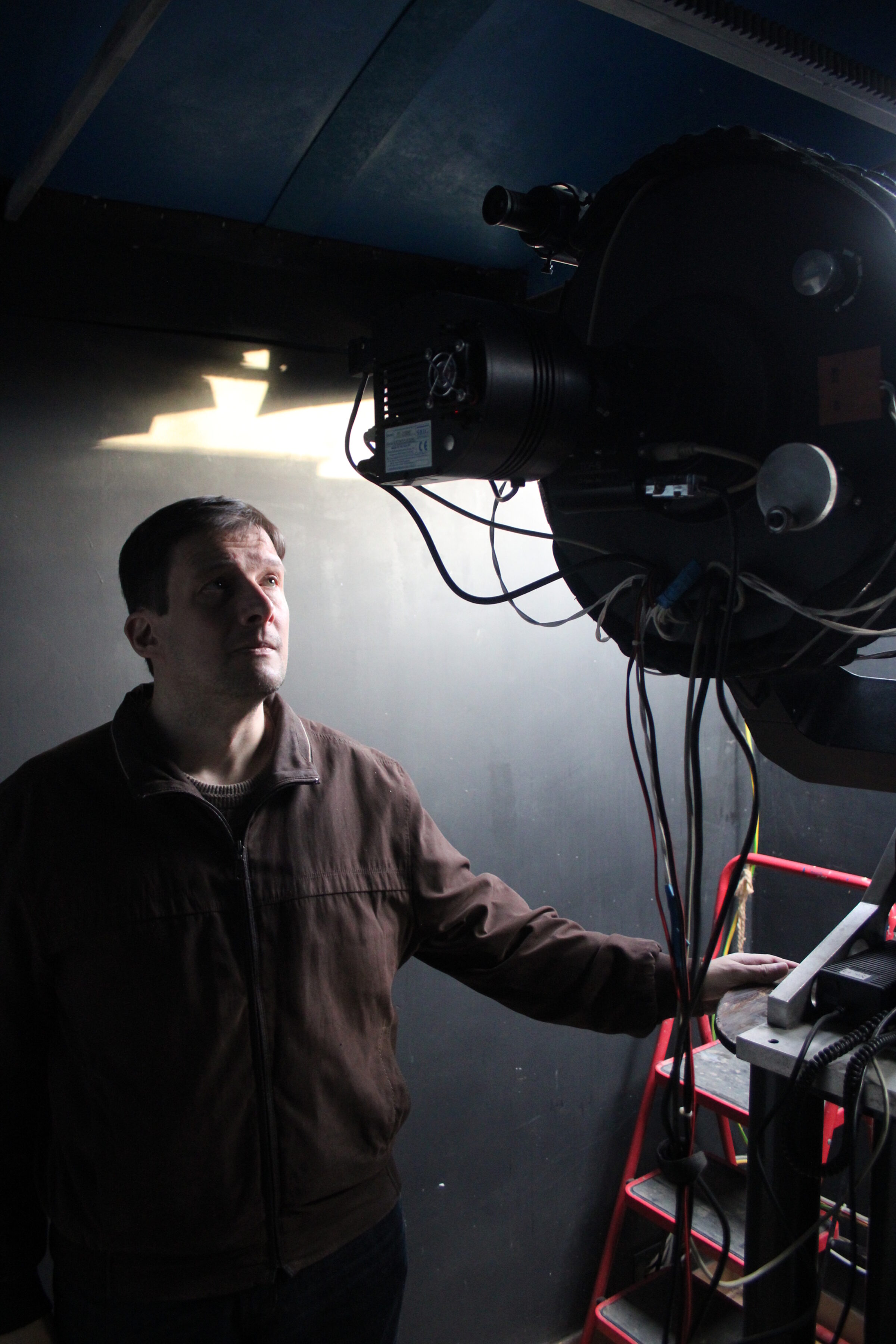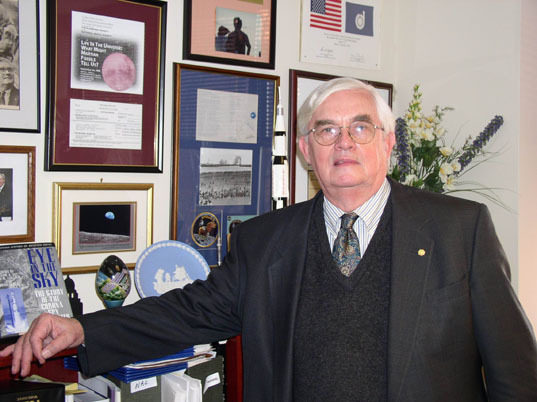Your impact: September equinox 2024
Exploring Europa, thanks to you
By Casey Dreier, Planetary Society Chief of Space Policy
Jupiter's moon Europa is one of the most promising targets in the search for life beyond Earth. Beneath its icy crust lies a layer of liquid water that may be hospitable to life as we know it. The Europa Clipper mission, which at the time of writing is due to launch in early October 2024, will make at least 45 flybys of Europa, maybe even soaring through plumes of water that shoot through the moon’s crust.
Although NASA has stated that Europa Clipper is not officially a life-detection mission, it still holds the potential to expand our understanding of whether alien life in our Solar System is possible. While this mission is exciting and promising, its journey to the launch pad has been long and arduous. And without the efforts of The Planetary Society and members like you, the mission might never have happened.
In the summer of 2012, NASA’s budget was shrinking, a divided government had all but frozen Congress, and the U.S. was pulling back from planetary exploration. It was a tough time for space advocates, and the ambitious, exciting missions outlined in the decadal survey — to begin a Mars Sample Return campaign and to explore the ocean world of Europa — felt like impossible dreams.
The successful landing of the Curiosity rover would spur NASA to move forward with what became the Perseverance mission to Mars. But a mission to Europa was not yet a reality. So, in January 2013, during a strategy session in preparation for the upcoming NASA budget cycle, The Planetary Society made a bold decision. Despite myriad political obstacles, we resolved to fully commit to Europa as one of our priority advocacy goals.

Despite the challenges, we felt confident about our prospects. The compelling nature of the mission was undeniable: to better understand a potential abode for “living” life by scouting an ocean moon of Jupiter. How could one not get excited about that? The scientific community had blessed it as one of their top recommendations from the respected decadal survey process, the mission had been reimagined as a multiflyby concept (rather than an orbiter) to make it cheaper, and we found strange political bedfellows in the form of Representatives Adam Schiff (D-CA) and John Culberson (R-TX), the latter of whom was rapidly becoming a Europa apostle in his own right.
For the following three years, it felt like every other word out of my mouth was “Europa.” We published Europa-themed issues of The Planetary Report, blog articles, and op-eds. We held numerous standing-room-only events on Capitol Hill to promote the mission. Bill Nye and I walked what felt like hundreds of miles of hallways in the Capitol, meeting with members to build support and spread the word. Bill even made a direct pitch to President Obama himself during a helicopter ride to an Earth Day event in 2015 (it didn’t work, but it was worth a shot).
Planetary Society members also participated en masse. Between 2013 and 2016, you all sent 384,949 messages to Congress and the White House to support planetary exploration and Europa — a record number that stands to this day.
At times it felt Sisyphean: Congress would add tens of millions of dollars to NASA’s budget for Europa only to have the agency redirect it to other missions. But we kept pushing. The White House’s budget office (which flatly refused to fund the mission) began to express annoyance at the sustained efforts in their NASA budget documents, asserting that “NASA is not able to support the development of an outer planets flagship for the foreseeable future” in the fiscal year 2014 request.

The next year, NASA formally requested money for the Europa Clipper mission. Though it was a paltry $15 million, it was a start. John Culberson, now the powerful chair of the House Commerce, Justice, and Science Appropriations Subcommittee, gave NASA $100 million instead. The following year, NASA asked for another paltry amount, slow-walking the mission despite obvious political support. Culberson provided $175 million. The White House resisted until the end, with its final budget requesting a mere $49 million. Culberson ensured it got $275 million. It wasn’t until the 2018 budget request that NASA finally asked for the funding it needed to launch Europa Clipper by 2024. Since then, Congress has obliged the request every year.
Many people worked to ensure Europa gets the exploration it deserves, and many more have spent countless hours designing, building, and testing the spacecraft that should launch this fall. Nonetheless, as Europa Clipper starts off on its long and storied mission, I hope that every Planetary Society member takes a moment to pat yourself on the back. Europa does not give up its secrets easily, but now, for the first time in human history, we will seek them out — not because of fate but because we decided to go.
Board of directors update: Welcoming Dr. Newton Campbell Jr. and saying farewell to Dr. John Logsdon
We are pleased to announce the appointment of Dr. Newton Campbell Jr. to The Planetary Society’s board of directors. Newton, a renowned leader in the space industry, serves as the director of space programs at the Australian Remote Operations for Space and Earth (AROSE) Consortium. His extensive background in artificial intelligence (AI) significantly contributed to advancements in space exploration and remote operations technologies. Prior to joining AROSE, Newton was an AI expert at NASA, where he led various innovative projects in urban air mobility, geomagnetism, space radiation, virtual reality, and high-performance computing.
In parallel, we are also announcing the departure of Dr. John Logsdon from the board. His service to The Planetary Society has had a profound impact. Professor emeritus of political science and international affairs at George Washington University’s (GWU) Elliott School of International Affairs, John was a pioneering figure in space policy and is one of the world’s preeminent space historians. He founded and directed GWU’s Space Policy Institute, significantly influencing U.S. and international space activities. John’s distinguished career included numerous publications and prestigious awards, reflecting his exceptional contributions to the space community. He authored seminal works such as “John F. Kennedy and the Race to the Moon” and “After Apollo? Richard Nixon and the American Space Program.”
The Planetary Society’s board now includes 13 members: Jim Bell, Newton Campbell Jr., Bethany Ehlmann, Daniel T. Geraci, John Grunsfeld, Heidi Hammel, Bijal “Bee” Hayes-Thakore, Lon Levin, Bill Nye, Robert Picardo, Britney Schmidt, Dipak Srinivasan, and Lorne Trottier.
Life may exist out there, but we need to defend it here
The Planetary Society works to support the search for life in the Cosmos because it is inspiring, ambitious, and visionary; because it’s an important endeavor that has the potential to change what it means to be an Earthling. But it can only happen if we’re here to carry it out. That’s why planetary defense is just as important to us. By finding, tracking, characterizing, and learning to deflect asteroids, we can ensure that humanity sticks around long enough to find our cosmic kin. Year-round, we support work to do just that. Here are some updates from the asteroid hunters and researchers whom we fund, thanks to the support of members like you.
Shoemaker NEO Grant winner updates
Every two years, The Planetary Society awards a series of grants to asteroid hunters through our Shoemaker Near-Earth Object (NEO) Grant program. Grant recipients are typically very advanced amateur astronomers from around the world who track, characterize, and discover near-Earth objects. Since the grant program began in 1997, Shoemaker grantees have submitted hundreds of thousands of asteroid observations to the International Astronomical Union’s Minor Planet Center, a clearinghouse for the world’s asteroid observations. Below is a sampling of updates and photos from some of our recent grant recipients.

From Cristovao Jacques of the SONEAR (Southern Observatory for Near Earth Asteroids Research) Observatory in Brazil: “In 2021, we were awarded the Shoemaker Grant, which allowed us to purchase two items to upgrade our observation program. Since the start of use of the equipment, both the new camera and the synthetic tracking technique have allowed us to discover 12 NEOs.”

From Gonzalo Fornas of Spain: “Thanks to the new camera, we’ve reported more measurements of NEOs to the Minor Planet Center, we’re on the alert list for near-Earth asteroids ‘Meerkat’ by ESA, we’ve measured light curves of asteroids and calculated their poles, we’ve published in the Minor Planet Bulletin, and we’ve collaborated on the Exoclock project by measuring planetary transits.”
From Grzegorz Duszanowicz in Sweden: “Thanks to the grant I received from you last year, I was able to launch an additional telescope, which I also use to look for NEOs. It was purchased and installed with your funds at the observatory in Namibia in September last year. The advantage of this new instrument is that it doubles the majority of searches each night and that on windy nights, it can still observe because it is less susceptible to wind. The equipment works practically every possible (observable) night.”

From Florent Losse of France: “The observatory has followed up [on] more than 700 newly discovered NEOs since January 2023, making it one of the most prolific. This period has had some highlights, such as my second NEO discovery (2023 DE3) and the tracking of impactors 2023 CX1 and 2024 BX1 just minutes after their discovery by K88. These hit Earth’s atmosphere over France and Germany respectively without any damage and provided valuable fragments found after the impact. Thanks again — these things would have been much more difficult or impossible without the help of The Planetary Society.”
Partnering and fundraising for planetary defense
The Planetary Society's members came together to raise over $65,000 in June and July for our planetary defense program. It’s through this program that we fund asteroid hunters, contribute to international coordination on asteroid research, educate the public and policymakers about the importance of planetary defense, and more. Thanks to your support, The Planetary Society will continue working hard to keep our planet safe from impacts.
As part of our overall planetary defense work, we partnered with Asteroid Day again this year to celebrate the international day of asteroid awareness. You can go to asteroidday.org to learn more about the global events that took place on June 30 this year.
New insights into asteroid properties: A STEP Grant update
One of the first recipients of The Planetary Society’s STEP (Science and Technology Empowered by the Public) Grant program was a project to better understand near-Earth asteroids. This year, that project achieved its main goals and scientific objectives.
In 2022, The Planetary Society awarded a $44,842 grant to a team from the University of Belgrade, Serbia, led by Professor Bojan Novaković, for their proposal “Demystifying Near-Earth Asteroids.” This project aimed to develop and apply a new method for determining the physical properties of asteroids with orbits that come close to Earth’s orbit (also called near-Earth asteroids, or NEAs). Although tens of thousands of NEAs have been found, we only know the physical properties of a small percentage — from solid rock asteroids to collections of boulders to fluff balls.
Over the course of their two-year project, Novaković’s team introduced an innovative tool named the Asteroid Thermal Inertia Analyzer (ASTERIA) to measure how well asteroids retain heat, giving insight into their composition and structure.
Unlike traditional thermo-physical modeling-based methods that involvecomplex calculations, ASTERIA simplifies the process using a random sampling approach to predict the thermal inertia based on how asteroids drift over time due to the Yarkovsky effect — a subtle force acting on rotating bodies in space caused by the emission of thermal photons. ASTERIA is especially useful for smaller asteroids, where traditional models struggle because they do not have enough data.
The project team tested ASTERIA on the well-studied asteroid Bennu and 10 other near-Earth asteroids. Their results were consistent with previous findings from other methods, validating the ASTERIA method while also proving it as a useful way of independently confirming findings from other techniques in the future.
One particular part of the project focused on the asteroid Didymos and its moonlet Dimorphos, which was the target of NASA’s DART mission. When the DART spacecraft intentionally impacted Dimorphos in September 2022, it proved an asteroid deflection technique and in doing so, turned Dimorphos into an “active asteroid,” ejecting debris that may have settled on both the moonlet and its host asteroid.

Novaković’s team examined Didymos’ thermal inertia before and after the impact, using ASTERIA to assess how Didymos’ ability to retain heat might have shifted due to the reaccumulation of debris generated by the collision. The results suggested that Didymos’ thermal inertia either remained the same or changed only slightly, below the threshold that their methodology could detect. These findings shed light on the question of how collisions might have altered the surfaces of these space rocks and add to the overall understanding of the physical properties of near-Earth asteroids.
This project, made possible by the support of The Planetary Society and our members, represents an important step forward in the global effort to understand asteroids that could someday pose a threat to our planet.
Support our core enterprises
Your support powers our mission to explore worlds, find life, and defend Earth. You make all the difference when you make a gift. Give today!
DonateThe Planetary Report • September Equinox
Help advance space science and exploration! Become a member of The Planetary Society and you'll receive the full PDF and print versions of The Planetary Report.


 Explore Worlds
Explore Worlds Find Life
Find Life Defend Earth
Defend Earth




